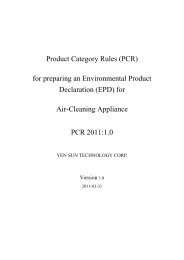Download(PDF) - PCR Library
Download(PDF) - PCR Library
Download(PDF) - PCR Library
Create successful ePaper yourself
Turn your PDF publications into a flip-book with our unique Google optimized e-Paper software.
crude steel + 0.32 x GHG emissions of iron ore)<br />
Converter aluminum lid exemption = {S3 x R1 + {S3 x (1 R1) x 0.01} x R2 x {4.6 [GHG emissions from crude<br />
steel] 7.1 x [GHG emissions from iron ore]}<br />
S1: weight of steel in used steel can<br />
S2: weight of steel in die-cutting scrap metals<br />
S3: weight of an aluminum lid in used steel can<br />
R1: recycling rate<br />
R2: percentage of steel cans that are recycled into converter steel<br />
Source: "Steel Can LCA Examination Report" by the Steel Can LCA Study Committee (published in July 2003)<br />
C.1.4 Indirect impact<br />
Among steel cans that are collected as recyclable garbage (R1), the recycling effect of the ones that are mixed<br />
with steel cans collected from intermediate treatment 2 during intermediate treatment 1 ((1-R1) x 0.01) and<br />
die-cutting scrap metals generated in the container/packaging production stage, and that are recycled into electric<br />
furnace steel (1-R2), may be calculated using the formulas below for additional information to be displayed.<br />
Note that the electric furnace aluminum lid exemption formula shall be applied only when the "aluminum end metal<br />
and board manufacturing" specified in the Database of GHG Emission Factors is used in the container/packaging<br />
raw material acquisition stage.<br />
Recycling effect of electric furnace steel<br />
= electric furnace open-top can exemption + electric furnace aluminum lid exemption<br />
Electric furnace open-top can exemption<br />
= {[S1 x R1 + S1 x (1 R1) x 0.01 + S2] x (1 R2)} x (GHG emissions from crude steel GHG emissions from<br />
recycling steel cans into electric furnace steel)<br />
Electric furnace aluminum lid exemption<br />
= {[S3 x R1 + S3 x (1 R1) x 0.01] x (1 R2)} x 6.9 x GHG emissions from electricity<br />
S1: weight of steel in used steel can<br />
S2: weight of steel in die-cutting scrap metals<br />
S3: weight of an aluminum end in used steel can<br />
R1: recycling rate<br />
R2: percentage of steel cans that are recycled into converter steel<br />
Source: "Steel Can LCA Examination Report" by the Steel Can LCA Study Committee (published in July 2003)<br />
C.1.5 Transport scenarios<br />
Calculate GHG emissions during transport of used steel cans and die-cutting scrap metals based on the fuel<br />
consumption data (light oil) provided in the table below.<br />
Table C.1 Used steel can transport scenarios<br />
Transport means<br />
(1)<br />
Distance (km/t)<br />
-16-<br />
(2)<br />
Truck mileage<br />
(km/L)<br />
(1)/(2) Light oil<br />
consumption (L/t)<br />
Transport A 2-ton garbage truck 109.68 7.0 (light oil) 15.669<br />
Transport B 10-ton truck 2.15 3.5 (light oil) 0.614<br />
Transport C 2-ton garbage truck 50.91 7.0 (light oil) 7.273<br />
Transport D 2-ton garbage truck 50.91 7.0 (light oil) 7.273<br />
Transport E 10-ton truck 1.07 3.5 (light oil) 0.306<br />
Source Source 1 Source 2<br />
Source 1: “Quantitative Analysis of Recycling of Waste Packages" by Nomura Research Institute (published in<br />
March 1995)<br />
Source 2: "Research Project Report on LCA of a Container and its Packaging in FY2004" by the Institute for<br />
Policy Sciences, Japan (published in March 2005)















